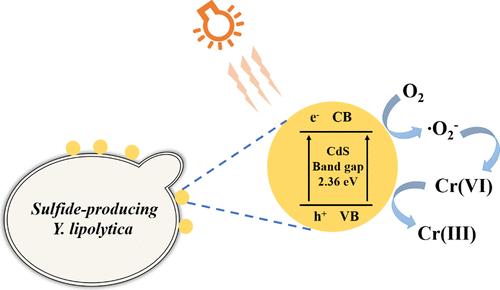利用太阳能光催化还原六价铬:一种高性能的聚脂耶氏菌- cds生物杂化体系
IF 8.2
2区 材料科学
Q1 MATERIALS SCIENCE, MULTIDISCIPLINARY
引用次数: 0
摘要
光合半导体生物杂合体结合了半导体的光收集能力和全细胞微生物的催化活性,在推进生物修复技术方面显示出巨大的潜力。然而,以酵母为基础的生物杂交系统用于污染物去除的报道很少。在这项研究中,我们构建了一个基于多脂耶氏菌的全细胞生物杂交体系,该体系具有原位合成的生物相容性硫化镉纳米颗粒(CdS),用于在紫外线照射下光催化还原六价铬[Cr(VI)]。这些CdS NPs整合到修饰的脂质体y细胞表面,使该体系具有优异的光催化性能,在2小时内实现100%的Cr(VI)还原。该体系具有较高的动力学常数(0.03 min-1)。在捕集实验中,活性氧(ROS)产生光化学反应,特别是超氧阴离子(•O2 -),这被认为是促进Cr(VI)还原的关键介质。脂聚Y.脂聚Y. cd生物杂合体活性的增强归因于高效的电子转移。此外,通过转录组分析,我们发现差异表达基因与膜转运、氧化还原过程、能量代谢和电子转移有关。这种全细胞生物混合催化策略有望成为一种减少Cr(VI)的创新方法,并有可能增强我们对光、无机材料和微生物之间相互作用的理解。本文章由计算机程序翻译,如有差异,请以英文原文为准。

Harnessing Solar Energy for the Photocatalytic Reduction of Hexavalent Chromium: A High-Performance Yarrowia lipolytica–CdS Biohybrid System
Photosynthetic semiconductor biohybrids, which combine the light-harvesting capacity of semiconductors and catalytic activity of whole-cell microorganisms, show substantial potential for advancing bioremediation technology. However, few yeast-based biohybrid systems for pollutant removal were reported. In this study, we have constructed a whole-cell biohybrid system based on Yarrowia lipolytica featuring in situ synthesized biocompatible cadmium sulfide (CdS) nanoparticles (NPs) for the photocatalytic reduction of hexavalent chromium [Cr(VI)] under UV irradiation. The integration of these CdS NPs onto the surface of modified Y. lipolytica cells endowed the system with excellent photocatalytic performance, achieving 100% Cr(VI) reduction within 2 h. The system exhibited a higher kinetic constant (0.03 min–1). In the trapping experiments, the reactive oxygen species (ROS) generated photochemically, specifically the superoxide anion (•O2–), which were identified as crucial mediators that facilitate the reduction of Cr(VI). The enhanced activity of the Y. lipolytica–CdS biohybrid was attributed to efficient electron transfer. Additionally, through transcriptome analysis, we found that the differentially expressed genes are associated with membrane transport, oxidation–reduction process, energy metabolism, and electron transfer. This whole-cell biohybrid catalytic strategy holds promise as an innovative approach for the reduction of Cr(VI) and has the potential to enhance our understanding of the interactions among light, inorganic material, and microorganisms.
求助全文
通过发布文献求助,成功后即可免费获取论文全文。
去求助
来源期刊

ACS Applied Materials & Interfaces
工程技术-材料科学:综合
CiteScore
16.00
自引率
6.30%
发文量
4978
审稿时长
1.8 months
期刊介绍:
ACS Applied Materials & Interfaces is a leading interdisciplinary journal that brings together chemists, engineers, physicists, and biologists to explore the development and utilization of newly-discovered materials and interfacial processes for specific applications. Our journal has experienced remarkable growth since its establishment in 2009, both in terms of the number of articles published and the impact of the research showcased. We are proud to foster a truly global community, with the majority of published articles originating from outside the United States, reflecting the rapid growth of applied research worldwide.
 求助内容:
求助内容: 应助结果提醒方式:
应助结果提醒方式:


